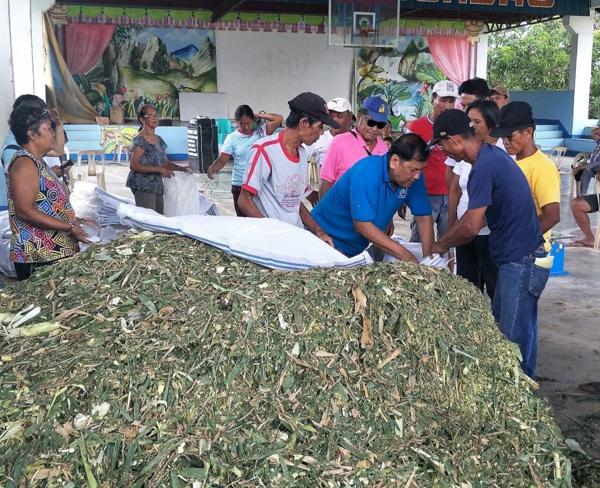The Philippines imports most of its milk requirements from leading dairy producing countries. Stated in the Philippine Dairy Update (Jan-Jun 2018) by the National Dairy Authority, the dairy supply situation is characterized by increasing local milk production, despite the availability of huge land areas suitable for livestock raising for the first semester of 2018, milk and dairy products had increased by six percent.

The dairy cattle industry is one of the primary sources of income among cattle raisers, especially the farmers from the province of Isabela in Cagayan Valley, where there is a wide range of rice and corn fields, and therefore could be an abundant source of feed resources (i.e. green corn as forage/silage, rice straw, corn stover)
However, despite the vastnesses of areas, many dairy farmers are still faced with scarcity problem of quality feed resources for dairy animals especially during dry season. The supply of forage is very low during the dry spell. The wet season is the peak season wherein quality feeds are high in supply, therefore contributing to the good milk production of cows.
To address feed quality and scarcity, and improve the current state of the dairy sector, it is recommended to come up with quality feed and roughages that will be made available all-year-round. Forages and roughages are the backbone of the industry, because ruminants like cow depend on them for milk and meat production.
Farmers need to be proficient in managing the development of forages and having an alternative supply of quality forage during lean months will help reduce the cost of feed production and increase milk production and profit. A possible approach that can be made is through forage production and silage, enriched with locally-available fodder, could provide a year-round consistent feed supply with low-cost quality nutrients for livestock.
To operationalize the supply of quality forages, the Bureau of Agricultural Research (BAR) is currently working with the Isabela State University (ISU) on a BAR-funded project, “Adoption and Commercialization of Green Corn, Green Corn-based Silage, Haylage and UMMB Production for Dairy Cattle in Cagayan Valley”. Leading the projects are Dr. Nilo E. Padilla and Dr. Diosdado C. Cañete of ISU in collaboration with Department of Agriculture Region-Regional Field Office 2.
The primary of objective of the project is to improve dairy production and ultimately increase the income of dairy farmers through the utilization of green corn silage, haylage and Urea Molasses Mineral Block (UMMB) supplementation using locally available feed resources.
According to the project proponents, green corn silage production, nutrient-enriched rice straw (as haylage) and the use of UMMB have been proven to improve nutrition among dairy animals, and thus improving milk and meat production.
Corn silage is a high energy feed resource for ruminants being part forage and part grain. In terms of nutrient content, corn silage is lower in crude protein and higher in digestible energy than other forages. Corn is relatively easy to ensile. As a minimum feed requirement, it is essential to provide a green fodder supplement to enhance rumen function for bovine animals and to increase milk production. Forage conserved this way is known as ‘ensiled forage’ or ‘silage’ and will keep for up to three years without deteriorating. Silage is very palatable to livestock and can be fed at any time. It is also considered the most convenient way to conserve forage crops.
According to the report of ISU, the project has been piloted in Malaya Development Cooperative (MDC) and Quezon Dairy Farmers Cooperative. The farmers tapped in the piloted areas will plant corn and will be at 70-85 days old corn. Corn will be chopped and packed in a 30-40 kgs capacity sacks with polyethylene bag, air removed from the bags using vacuum pump, sealed, and stored in a place safe of rats. The silage is ready for feeding after 3 weeks in storage.
On-site and experiential learnings on: 1) production of silage, haylage, and UMMB, 2) showcasing or demonstration feeding of silage and haylage, use of UMMB as feed supplement, 3) cooperative/ association strengthening, among others have already been conducted.
As a result of the awareness campaign and capability building component of this BAR-funded project, the MDC has fully adopted silage as feed to their dairy animals. Milk production has gradually increased from 3 liters/ head/day to 10-11 liters/ head/ day. The cooperative is now growing their own corn for silage production, while the other coop is now ready to produce their own silage.
With the project on board, BAR and ISU project is expected to address the year-round availability of nutrient-rich feedstuff for dairy cattle/carabao; increased lactation period, milk production per head and total milk production (community, municipality, province, region); higher household income; improved nutrition of farm families, and less dependence on imported milk and milk products. ###
by Patrick Raymund A. Lesaca, https://www.bar.gov.ph
————
For more information:
Dr. Nilo E. Padilla and Dr. Diosdado C. Cañete
Professor VI and Associate Professor IV
Isabela State University, Echague, Isabela
Telephone Number(s): 09163225967 and 09088620681
Fax Number: (078) 305-0120 2.7.
Email Address: [email protected] and [email protected]


